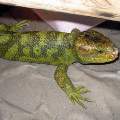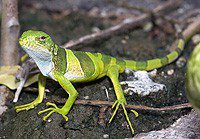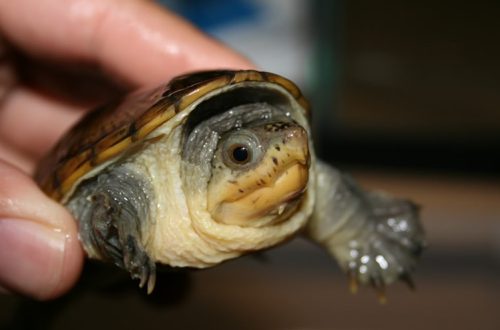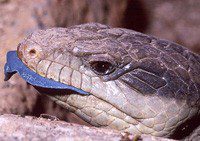
Blue-tongued skink
Blue-tongued skinks (lat. Tiliqua) are large lizards with a smooth body, they mainly live in Australia and Oceania. Terrariumists call these animals “domestic cats” among lizards, they are affectionate, friendly and absolutely not aggressive. In nature, about 7-8 species of various blue-tongued skinks are known. They owe their amazing name to the bright purple color of the tongue. Australian skink species are named according to their habitats. For example, Intermedia skinks live in the north. And from the southern species, they differ in color. Northern blue-tongued skinks are the easiest to distinguish from others – their coloration is predominantly light brown with a pattern of black, orange or yellow stripes. And southern skinks have a darker body color. It is almost impossible to buy a real Australian blue-tongued skink for your own terrarium today, since Australian laws prohibit the export of these lizards, as well as other representatives of the local fauna, from the country. Therefore, most likely, it will be possible to buy a skink artificially bred in some nursery. The selection of these lizards is a widespread phenomenon, since their artificial populations have to be maintained due to the inability to acquire and breed real Australian skinks.
Contents
Classification
Kingdom: Animals
Type: Chord
Class: Reptiles
Order: Scaly
Suborder: Lizards
Infraorder: Skinks
Family: Skink
Genus: Blue-tongued skinks
Species: The common blue-tongued skink is the most common species, but there are other interesting species besides it, such as the pygmy, giant, black and yellow, short-tailed, black-browed skink.
Appearance
 The common blue-tongued skink is perhaps the most typical member of the genus. It, like many other skinks, is large in size, it can grow up to half a meter or more in length. But standard terrarium skinks rarely reach more than 50 cm. There are also very small lizards – these are dwarf skinks up to 10 cm in size, and there are also giants, for example, the northern subspecies of the common blue-tongued skink can grow up to 70 cm. The body of blue-tongued skinks is wide, powerful , but as if flattened, with large scales, smooth and even iridescent in the light.
The common blue-tongued skink is perhaps the most typical member of the genus. It, like many other skinks, is large in size, it can grow up to half a meter or more in length. But standard terrarium skinks rarely reach more than 50 cm. There are also very small lizards – these are dwarf skinks up to 10 cm in size, and there are also giants, for example, the northern subspecies of the common blue-tongued skink can grow up to 70 cm. The body of blue-tongued skinks is wide, powerful , but as if flattened, with large scales, smooth and even iridescent in the light.
Despite the large size of the body, the triangular head of lizards with powerful jaws still stands out. But the legs of the skinks are short. There is a whole legend about these paws, as well as about the blue tongue of the reptile. It says that in order to heal his sick owner, the skink had to carry healing ink in his mouth and run very fast. Since then, these lizards have been short-legged and blue-tongued. In fact, scientists have not fully figured out the origin of the color of the tongue in skinks. There is an assumption that the lizard needs it to scare away enemies, making up a bright contrast with the pink color of the mouth, as well as for the marriage ceremony, when the males, as they say, “measure their tongues” – who is more impressive.
Blue-tongued skinks have 5 toes on their paws. Also, lizards have a short and thickened tail, occupying about 60% of the body in length. Although the jaws of all skinks are powerful, the teeth are not sharp, but rather blunt, serving to crush food, and there is also a secondary palate.
The coloration of different types of blue-tongued skinks, as already mentioned, is quite diverse. Take at least an ordinary blue-tongued skink – depending on the habitat, gray, brown or yellowish tones predominate in the color of its body. Some individuals have black longitudinal stripes on the shoulders, transverse stripes on the back and sides, as well as a dark stripe from the eye to the shoulder.
All skinks have eyes located on the sides of the head and are equipped with a movable lower eyelid. Some representatives of the genus have several large scales on their temples, while others do not have this feature. If we talk about other types of blue-tongued skinks, then perhaps the most interestingly colored can be called a yellow-black lizard. The top of her body has a shade of brown to black, and the ventral part is light yellow.
Another member of the genus, the short-tailed blue-tongued skinks, has amazing scales. Each scale is convex, the color is predominantly dark brown with a light zigzag stripe. These skinks are the only lizards among the skinks that are not capable of dropping their tail in case of danger. They always need it, as nutrient reserves are deposited there. And the short-tailed one is the thickest skink among the blue-tongued ones.
And another blue-tongued skink – black-temporal, has the most contrasting color – light cream with thick dark stripes, as well as wide black stripes on the temples, which is why it is called that.
Distribution and habitation
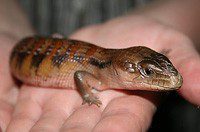 It so happened that the genus of blue-tongued skinks became isolated on the Australian mainland and the nearby islands – Tasmania, New Guinea and eastern Indonesia. And already different types of skinks have chosen suitable places for themselves in this territory. So, for example, the common skink is found mainly in the southeastern regions of the mainland, in the north, as well as on some islands, for example, on Tanimbar. The black and yellow lizard lives in the neighborhood of the common skink, as well as in the north of Tasmania and the islands of Bass Strait. The black-temporal lizard shares with the common blue-tongued skink only the southern part of the northern range. Otherwise, she settled in the west and south of Australia, in states such as New South Wales and Victoria. And in the same place – in the south and west – there is a short-tailed skink, everywhere except for coastal areas.
It so happened that the genus of blue-tongued skinks became isolated on the Australian mainland and the nearby islands – Tasmania, New Guinea and eastern Indonesia. And already different types of skinks have chosen suitable places for themselves in this territory. So, for example, the common skink is found mainly in the southeastern regions of the mainland, in the north, as well as on some islands, for example, on Tanimbar. The black and yellow lizard lives in the neighborhood of the common skink, as well as in the north of Tasmania and the islands of Bass Strait. The black-temporal lizard shares with the common blue-tongued skink only the southern part of the northern range. Otherwise, she settled in the west and south of Australia, in states such as New South Wales and Victoria. And in the same place – in the south and west – there is a short-tailed skink, everywhere except for coastal areas.
The biotopes preferred by blue-tongued skinks are diverse. They easily adapt to life in desert and arid areas, as well as in the lowland and mountain Australian forests and on the coasts. Some skinks need available vegetation nearby, and some, say the shorttail, will also benefit from a poor semi-desert forage, since it has enough resources hidden in the tail. And sometimes blue-tongued skinks settle in the suburbs of Australia next to people, in gardens and in the backyards of houses.
In terms of climate, lizards are also unpretentious. They can choose tropical rainforests, but they also feel fine in cold mountainous regions, and in savannahs, and in shrubs, and in dry vegetation. During the day they go out to bask in the sun and look for food, and at night they hide in various shelters – burrows, heaps of leaves or under fallen tree trunks.
Behavior and lifestyle
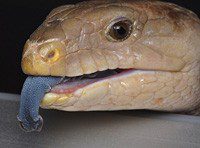 Blue-tongued skinks are active during the day, but they do not really like the heat, so they hide from the heat in various shelters. They can, for example, take someone else’s hole or even climb into a crack in the ground. Blue-tongued skinks guard their territory strictly and aggressively chase away strangers who have wandered into it. In vegetation, lizards are able to crawl along the ground under the lowest branches due to the flat shape of their body. By nature, blue-tongued skinks are loners. They live in pairs only during the breeding season. If the lizard feels danger, then it immediately becomes in a defensive posture of intimidation – it inflates its body, hisses, opens its mouth wide and shows a blue tongue. Often the contrast of the tongue and mouth of the skink frightens the enemy. And blue-tongued skinks climb trees perfectly, although they are more likely to be terrestrial species of lizards. How many years these reptiles live in the wild is not precisely defined, but in a terrarium or in a nursery they can last up to 20 years. And their behavior in artificial conditions, of course, differs from wild.
Blue-tongued skinks are active during the day, but they do not really like the heat, so they hide from the heat in various shelters. They can, for example, take someone else’s hole or even climb into a crack in the ground. Blue-tongued skinks guard their territory strictly and aggressively chase away strangers who have wandered into it. In vegetation, lizards are able to crawl along the ground under the lowest branches due to the flat shape of their body. By nature, blue-tongued skinks are loners. They live in pairs only during the breeding season. If the lizard feels danger, then it immediately becomes in a defensive posture of intimidation – it inflates its body, hisses, opens its mouth wide and shows a blue tongue. Often the contrast of the tongue and mouth of the skink frightens the enemy. And blue-tongued skinks climb trees perfectly, although they are more likely to be terrestrial species of lizards. How many years these reptiles live in the wild is not precisely defined, but in a terrarium or in a nursery they can last up to 20 years. And their behavior in artificial conditions, of course, differs from wild.
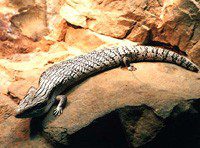 Blue-tongued skinks quickly get used to people and become very curious. But keeping several skinks of different or both sexes together is not recommended, as they can start to fight. Lizards move very slowly, because of their short legs, as if waddling, and from this they give the impression of clumsy creatures, although in reality they are not. Blue-tongued skinks, like other lizards, periodically molt. To peel off old dead skin, they rub against various hard objects, such as tree trunks or stones.
Blue-tongued skinks quickly get used to people and become very curious. But keeping several skinks of different or both sexes together is not recommended, as they can start to fight. Lizards move very slowly, because of their short legs, as if waddling, and from this they give the impression of clumsy creatures, although in reality they are not. Blue-tongued skinks, like other lizards, periodically molt. To peel off old dead skin, they rub against various hard objects, such as tree trunks or stones.
Lizards have excellent, although black and white vision, but there is another amazing organ – special receptors in the sky that allow them to “take samples” of the surrounding air, which blue-tongued skinks periodically do while walking around their territory. Reptiles feed not only on vegetation, but also on insects, which are easily hunted, feeling their slightest movements. Therefore, a skink can skip a motionless victim. Lizards must be handled with care, as they are able to bite significantly, even despite the lack of sharp teeth. And young blue-tongued skinks are generally quite aggressive. In fights, they easily bite off each other’s tails or limbs.
Food
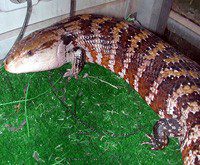 Blue-tongued skinks are omnivores. Most of their diet consists of various plants, but sometimes lizards dilute it by hunting small animals and insects. They will never refuse the fruits, leaves and flowers of plants, but they will also eat the found snail with pleasure, as well as destroy the ground nest with bird eggs or feast on carrion found by chance. Large blue-tongued skinks sometimes catch rodents and small lizards, and small individuals – cockroaches, ants, crickets and spiders.
Blue-tongued skinks are omnivores. Most of their diet consists of various plants, but sometimes lizards dilute it by hunting small animals and insects. They will never refuse the fruits, leaves and flowers of plants, but they will also eat the found snail with pleasure, as well as destroy the ground nest with bird eggs or feast on carrion found by chance. Large blue-tongued skinks sometimes catch rodents and small lizards, and small individuals – cockroaches, ants, crickets and spiders.
Herpetologists recommend feeding blue-tongued skinks in captivity according to this principle: it is better to make plant foods, vegetables, fruits, leaves, flowers and shoots as the basis of the diet, and gradually add pieces of meat, boiled eggs, small rodents and even canned cat food. And of course, it is very important to maintain the vitamin balance in the body of the blue-tongued skink. For this, special supplements for reptiles are sold in veterinary pharmacies. In general, skinks are not particularly picky eaters, so owners will have to be careful not to let their pet chew on anything unhealthy.
Reproduction
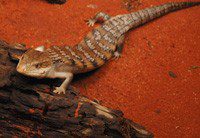 Perhaps only herpetologists are able to determine the sex of blue-tongued skinks. An amateur can’t handle it. The breeding season begins in these lizards in autumn, in September-November. Almost all types of blue-tongued skinks are characterized by monogamy, that is, for several years in a row they can reproduce offspring by the same pair. This is especially evident in the short-tailed skink, whose male and female can constantly live close to each other and unite during the mating season for a couple of months a year.
Perhaps only herpetologists are able to determine the sex of blue-tongued skinks. An amateur can’t handle it. The breeding season begins in these lizards in autumn, in September-November. Almost all types of blue-tongued skinks are characterized by monogamy, that is, for several years in a row they can reproduce offspring by the same pair. This is especially evident in the short-tailed skink, whose male and female can constantly live close to each other and unite during the mating season for a couple of months a year.
Mating in skinks occurs with courtship. The female defiantly walks in front of the male, and in order for the fertilization to proceed normally, the male, ready for mating, grabs the female by the neck.
Blue-tongued skinks, unlike other lizards, are viviparous. During pregnancy, a yolk placenta is formed in the body of the female, that is, we can say that she carries developing eggs inside, and when the embryos are ready to hatch, they are born along with the placenta, which they immediately eat. Pregnancy of blue-tongued skinks lasts 4 months. In nature, they give birth no more than once every two years. The number of young blue-tongued skinks is usually from 10 to 25 individuals. Babies are usually large and almost immediately independent. After a couple of days, they molt for the first time and begin to feed themselves, and within six months, the teeth of the young are changing.
Sources of
http://ru.wikipedia.org/
http://www.biopractice.ru/
http://www.reptisib.ru/
http://reptiles.boom.ru
http://zoo.link.ua/



